Manuscripts Etc.
| CLOSE WINDOW |

|
The following items are drawn from the William Faulkner Foundation Collection at the University of Virginia's Albert and Shirley Small Special Collections Library (http://small.library.virginia.edu/).
|
|
There are well over six hundred pages of Intruder typescript in the University of Virginia's Faulkner collection — and one page of manuscript, the handwritten version of the novel's first page below left. Below right is first typescript page in the collection. Earlier in his career Faulkner composed his texts in that cramped longhand of his, then typed them over for submission to publishers, but in this case a comparison of both pages with each other and with the novel's published beginning leaves no doubt that the typed version here came first. Faulkner also wrote the notes in the margin of this manuscript, which suggest he is still in the early stages of composition. Since we have only this one handwritten page, it's not clear what it tells us. Why he decided to write rather than type, or how many more pages he may have handwritten before going back to the typewriter — these are mysteries we cannot solve.  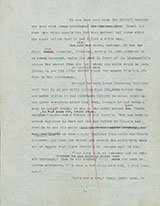
What those hundreds of typed pages reveal is how hard Faulkner worked to tell this story, despite his hopes of finishing quickly and his urgent need for money. After six weeks of writing he confessed to Robert Haas, his editor at Random House, that "the rewrite will actually be the writing of it, which will take some time yet." To economize, Faulkner often wrote on the clean sides of discarded pages. Below left is the back of that typed first page above. Its cancelled top half is a different typed draft of the novel's beginning. Its bottom half, written later and then also cancelled, is from page "4." and describes Chick's first sight of Lucas' home as recalled in his flashback in Chapter 1. The interlineated handwritten passage is one version of a part of a sentence from Chapter 9. Next to it (below middle) is page "2." and page "230." — a typed and cancelled continuation of the first page with another version of that passage from Chapter 9 written in the white spaces between the typed lines. Next to that (below right) is page "3." with yet another interlineated version of the passage from Chapter 9. In a later letter Faulkner told Haas that he had "to do so much more rewriting before sentences come exactly right than I used to." In the published novel, the sentence he's repeatedly rewriting here is over a page long; it's an example of the "Faulknerian" style that many find hard to read, but we should also appreciate how hard the author himself worked to write it. 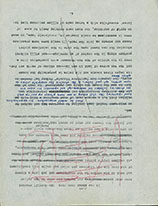 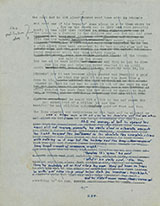 
The typescript's record of Faulkner's struggle to get his story right includes, for example, fifteen different versions of the beginning of Chapter X — or XI, in some of the versions. It's probably impossible to tell how many different "preliminary" typescripts there may have been, how many pages may have been discarded rather than or after being re-used. In his facsimile edition of this material (Garland Publishing, 1987), the great Faulkner scholar Noel Polk labels page "8." (below left) the main page, and its other side, page "226-A." (below center), its "verso." But it seems equally likely that Faulkner is re-using page 8 from some earlier typescript as he writes page 226-A. The interlineations on 8 are where the typed text on 226-A starts. The result is not quite a palimpsest, but it often provides some fascinating moments. Here, for instance, one side of the sheet depicts Chick learning to think in new ways about the black people he has always lived among; the other side, from the other end of the narrative, includes part of his unsettling discovery about the white people in his world. The page below right offers a very different kind of moment. Faulkner typed page 85 on the unused side of the draft of a letter to "Mr Russell," whose cattle had strayed onto Faulkner's Greenfield Farm northeast of Oxford — not far in fact from the where, in his fictional world, much of Intruder takes place, although the incident itself instead recalls Jack Houston's trouble with Mink Snopes in The Hamlet.  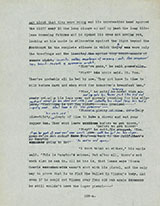 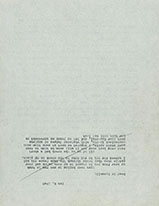
Below left: one of the most interesting moments in the extant typescript pages appears on what begins as a different page 8 (its fifteen words complete the sentence that begins on the extant page 7). Faulkner apparently considered using the convention of an introductory fictional disclaimer to make explicit his ultimate rhetorical intention: to address his contemporaries about what was in 1948 increasingly being acknowledged as the nation's "southern problem." In the end, of course, he lets Gavin Stevens do the talking on this issue, but the next two pages (below center and right) show him still trying to take his own stand four months after the novel's publication. On these pages is the draft of the letter he sent Haas early in 1949, with two pages for insertion inside Stevens' speech to Chick about that problem. That new material contains the disconcerting prediction that the Negroes' fight for "social equality" will result in "racial extinction," along with the surprising introduction of himself (as "the mild retiring little man over yonder at Oxford") and his earlier novel Absalom, Absalom! into the world of Yoknapatawpha. (The page numbers here, 156A and B, refer to the first edition.) Fortunately, this passage was never added. 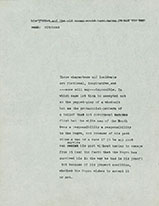 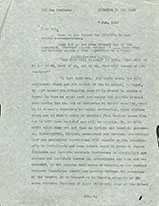 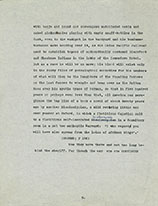
In the summer, 1948, M-G-M, the studio that Faulkner had worked for intermittently during the 1930s, bought the film rights to Intruder for $50,000. Faulkner's share of that money gave him financial freedom for the first time in his career. When M-G-M came to Oxford to shoot the movie in 1949, he agreed to read and revise the script — despite being under contract to Warner Bros. at the time. Nine hand-written pages of suggested script changes are in the Faulkner Collection. Below are four of these. Even with his new wealth, Faulkner was still frugal; these four pages are on the fronts and backs of two sheets of paper. They're organized here in narrative order: the first two pages (written in pencil) come from Chapter 3; the last two (written in ink), from Chapter 5. Most of the dialogue did get used in the film, which was released in October, 1949. (You can hear Faulkner's opinion of the movie among the Audio Clips.) 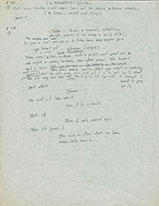 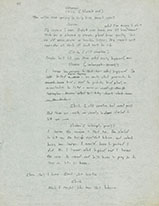  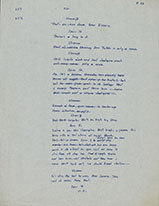 Citing this source: |
